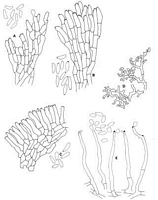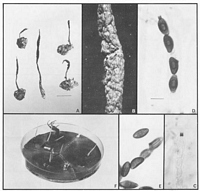|
 Xylaria palmicola Xylaria palmicola
BiostatusPresent in region - Indigenous. Non endemic
Images (click to enlarge)
Caption: Fig. 12 Xylaria anamorphs A, X. schreuderiana (from culture, PDD 43183). B, C, D, X.
apiculata (B: PDD 44271 from culture, C, PDD 44322 from nature, D, Sterile hairs
formed in cultures, PDD 44322). E, X. palmicola (PD | 
Caption: Fig. 10 Xylaria palmicola A, Stromata arising from seeds. B, Stromal surface. C, Ascal ring
(Melzer's reagent). D, Ascal ring with ascospores (Melzer's reagent). E, Ascospores with
germ slits (Melzer's reagent). F, Culture on OA. (PDD 42097; Li |
Article: Rogers, J.D.; Samuels, G.J. (1987) [1986]. Ascomycetes of New Zealand 8. Xylaria. New Zealand Journal of Botany 24(4): 615-650 (http://www.rsnz.org/publish/abstracts.php).
Description: Stromata solitary or gregarious, 2.5-4.5 cm long, unbranched with apex attenuated and
acute or enlarged and palmate. Fertile portion subapical, cylindrical, 1-2 cm long x 2.0-2.5
mm diam.; stipe sharply delimited from the fertile portion, 1-2 cm long x 1.0-1.5 mm
diam., with a velutinous coat of short, reddish hyphae. Stromal surface with brown tissue
cracking longitudinally, slightly tuberculate from perithecia) elevations; perithecia almost
completely immersed, 300-400 µm diam., ostioles difficult to see. Internal tissue of stroma
white, solid. Asci 130-140 µm total length x 5-6(-7) µm, sporiferous part (65-)74-87 (-90)
µm, cylindrical; 8-spored, apical ring cylindrical, J+, 2 µm high x 2-3 µm wide; ascospores
uniseriate with overlapping ends. Ascospores (8-)10-13(-16) x (4.5-)5.0-6.0(6.5) µm,
inequilateral with one side straight and the other curved; in top view elliptical to naviculate
with one end attenuated; transparent brown; slit full length or nearly so, parallel to the long
axis of the ascospore.
CHARACTERISTICS IN CULTURE: Colonies grown two weeks at 20°C in diffuse
daylight on OA 4.5 cm diam.; mycelium flat, white but with a blue-green ring around the
centre, incipient stromata sometimes forming in the centre of the colony; with a rose-coloured
pigment spreading into the medium; surface of colony eventually becoming dark
olivaceous and velvety; stromata forming within one month, erect, 2-3 cm long x 2 mm
diam. at base, branched, clothed in green hyphae; tip acute, white, conidiogenous.
Conidiophores arising from aerial hyphae along upper half of the stroma, loosely dispersed
and not forming a distinct palisade, unbranched, 25-55 µm long x 2-3 µm wide at base,
straight, smooth, hyaline; producing a small number of conidia at the tip, a minute denticle
remaining after conidial dehiscence. Conidia (4.0-)4.5-6.5(-8.0) x 2.0-2.5(-3.0) µm,
ellipsoidal, with a protuberant, flattened, weakly refractive basal abscission scar.
Habitat: HABITAT: Monocotyledonous trees.
Distribution: DISTRIBUTION: NORTH ISLAND: Northland, Auckland.
Notes: NOTES: Our concept of X. palmicolais that of Dennis (1956). The fungus described here
differs from his description in its somewhat smaller ascospores.
|